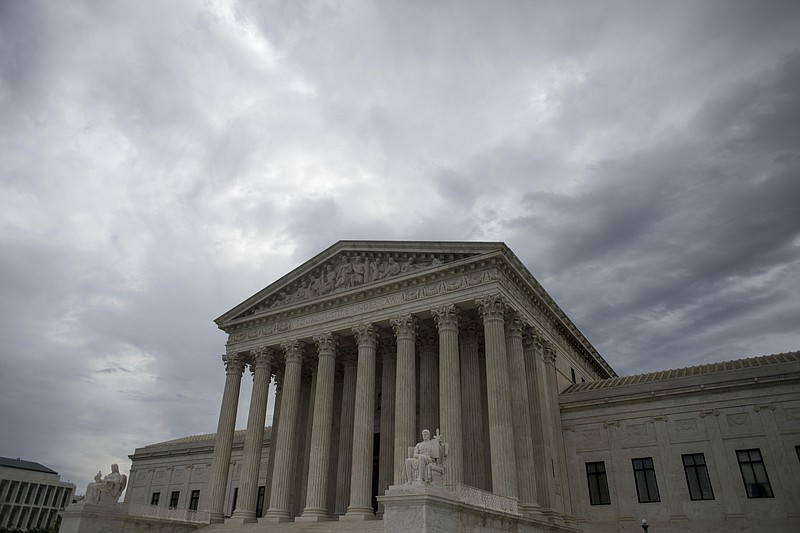It is long past time that the Supreme Count should decide whether redistricting for gerrymandering violates the Constitution, so we are delighted that the court has announced it will consider the question.
The court announced a decision to hear the case, Gill v. Whitford, on Monday, setting the stage for a ruling that may for the first time impose limits on a practice that has helped define American politics as divisive partisanship.
In the years since 1812 when Massachusetts Gov. Elbridge Gerry signed a law that created a voting district shaped like a salamander to help his party's electability, politicians have become expert at math and art on a voter map.
We should think of partisans rigging districts to achieve unrepresentative super-majorities as tyranny. Instead, we see it as swamp spoils of politics.
Over the years, the Supreme Court has struck down district maps as racial gerrymanders set up to disadvantage minority voters, but never has the court rejected a map on the grounds that it was drawn to give an advantage or disadvantage to a political party.
The new case the court has agreed to hear is an appeal of a decision striking down a legislative map for the Wisconsin State Assembly. The Wisconsin map was drawn after Republicans gained control of the state government in 2010. Lawmakers there promptly redrew state districts to help the GOP convert close statewide votes to lopsided majorities. In 2012 Republicans won only 48.6 percent of votes for state candidates but took 60 percent of the Assembly's 99 seats. In 2014, 52 percent of the vote statewide won 63 seats.
Paul Smith, the lawyer for voters who challenged the map, told The New York Times: "Partisan gerrymandering of this kind is worse now than at any time in recent memory. The Supreme Court has the opportunity to create ground rules that safeguard every citizen's right to freely choose their representatives."
We couldn't agree more. Our country fought a war to stop considering a man of color as 3/5 of a person, yet gerrymandering has equally diluted democracy, to the point where the word "dialogue" is essentially unknown in our Congress. The so-called health care bill being steamrolled through the Senate could not be a better example.
Previously, gerrymandering cases have brought mixed results among our high court judges. Court historians note that Justice Anthony M. Kennedy has taken a middle position, and next fall this case likely may turn on his vote.
Kennedy wrote in 2004 that he might consider a challenge to gerrymandering if there were "a workable standard" to decide when redraws crossed a constitutional line. This case offers a standard by measuring "wasted votes" that result from the two basic ways of injecting partisan politics into drawing districts - "packing" and "cracking."
Packing Democratic voters into a single district wastes every Democratic vote beyond the bare majority needed to elect a Democratic candidate, while cracking Democratic voters to spread them across districts in which Republicans have small majorities wastes Democratic votes as well. And, yes, the shoe could fit the other foot.
In a recent paper, University of Chicago law professor Nicholas O. Stephanopoulos, who also is a lawyer for the plaintiffs, and public policy researcher Eric McGhee devised a formula to measure partisanship. They postulate that the difference between the two parties' wasted votes, divided by the total number of votes cast, yields an "efficiency gap."
The gap in Wisconsin was 13.3 percent in 2012 and 9.6 percent in 2014, according to the formula. The Wisconsin voters who sued argue that gaps over 7 percent violated the Constitution. That number was meant to capture the likelihood that the gap would endure over a 10-year election cycle, but critics say it is arbitrary.
A 2015 report from Simon Jackman, then a political scientist at Stanford and an expert witness for the plaintiffs, found that a third of all redistricting plans in 41 states over a 43-year period failed the 7 percent standard. Jackman found that elections in 2012 and 2014 in Florida, Indiana, Kansas, Michigan, Missouri, North Carolina, New York, Ohio, Rhode Island, Virginia, Wisconsin and Wyoming featured efficiency gaps of more than 10 percent.
(Jackman also wrote that a number of Southern states - including Georgia, Alabama and Tennessee - have high numbers of uncontested races, making them difficult to score, yet too stark to ignore. Jackson noted that Stephanopolous and McGhee have written in their research: "We strongly discourage analysts from either dropping uncontested races from the computation or treating them as if they produced unanimous support for a party. The former approach eliminates important information about a plan, while the latter assumes that coerced votes accurately reflect political support.")
Appeals Judge Kenneth F. Ripple, a Reagan appointee who struck down the gerrymandered Wisconsin map, did not ground his opinion on the efficiency gap, but he did say that it corroborated his more conventional test of discriminatory intent.
The Republican National Committee countered that if Democrats lack electoral power, it is because of geography rather than gerrymandering, as Democrats are often concentrated in cities, effectively diluting their voting power.
Ripple, however, wrote that gerrymandering amplifies that geographic advantage.
The Supreme Court should hit the nation's reset button and adopt a reasonable standard or guide. Real democracy is at stake, and American elections should once again fairly reflect American voters.
